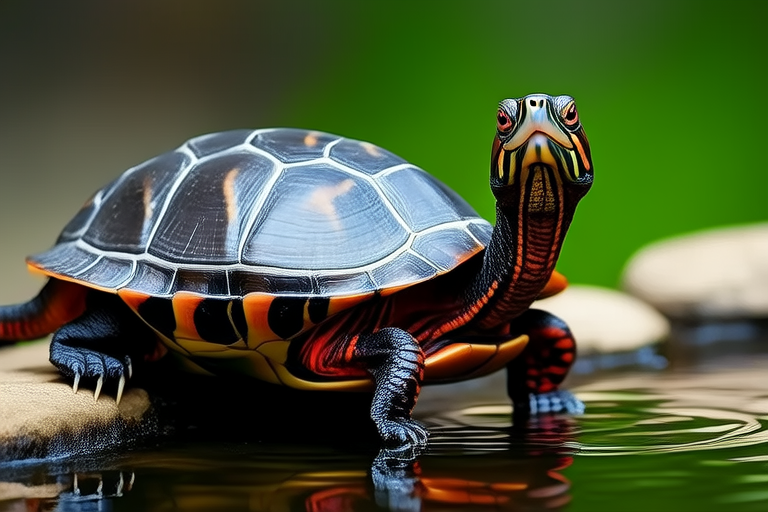Top 10 Myths About Red-eared Sliders You Need to Know
Red-eared sliders (Trachemys scripta elegans) are one of the most popular aquatic turtle species kept as pets worldwide. Their distinctive red markings behind the eyes and adaptable nature make them attractive to many turtle enthusiasts. However, misinformation about their care can lead to improper husbandry, affecting their health and longevity. This article aims to debunk ten common myths surrounding red-eared sliders, offering accurate information to ensure their proper care and well-being.
Myth 1: Red-eared Sliders Can Live in Small Bowls
Fact: Red-eared sliders require ample space to swim, bask, and explore. A small bowl confines them, leading to stress, stunted growth, and health issues. For a single adult slider, a tank size of at least 40 gallons is recommended, increasing by 10 gallons per additional turtle. The tank should include a water filtration system to maintain cleanliness and a basking area with UVB lighting.
Myth 2: Red-eared Sliders Don’t Need Special Lighting
Fact: Red-eared sliders need exposure to ultraviolet B (UVB) light to synthesize vitamin D3, essential for calcium absorption and bone health. Without adequate UVB, turtles can develop metabolic bone disease (MBD), leading to deformities and fractures. Providing a consistent 12-hour cycle of UVB lighting is crucial, alongside natural sunlight when possible.
Myth 3: Feeding Bread or Lettuce Is Fine
Fact: A balanced diet is vital for red-eared sliders’ health. Feeding them bread or lettuce alone is inadequate. Their diet should consist of commercial turtle pellets, supplemented with live or frozen feeder insects, earthworms, and occasional fruits or vegetables like bell peppers or berries. Proper nutrition ensures optimal growth, immune function, and overall vitality.
Myth 4: Red-eared Sliders Hibernate Indoors
Fact: In captivity, hibernation is unnecessary and potentially harmful. Wild red-eared sliders may brumate (a form of hibernation) during colder months, but this behavior isn’t required for captive turtles. Maintaining a stable temperature between 75°F and 85°F (24°C to 29°C) throughout the year ensures their active metabolism and prevents health complications.
Myth 5: Red-eared Sliders Only Need Water
Fact: Red-eared sliders are semi-aquatic, meaning they spend time both in and out of water. They require a basking area where they can dry off completely. The basking site should be warm, with temperatures around 90°F to 95°F (32°C to 35°C). This helps regulate their body temperature, aids digestion, and supports overall health.
Myth 6: Red-eared Sliders Grow to Fit Their Tank
Fact: Contrary to popular belief, red-eared sliders do not stop growing due to confinement. Instead, poor living conditions can stunt their growth. Adult sliders typically reach 10 inches (25 cm) in length, and some can grow up to 14 inches (35 cm). Ensuring they have sufficient space and appropriate care is key to achieving their full size potential.
Myth 7: Red-eared Sliders Are Low Maintenance Pets
Fact: While red-eared sliders are hardy, they still require attentive care. Regular maintenance includes cleaning their enclosure, checking water quality, monitoring their health, and providing a balanced diet. Neglecting these responsibilities can lead to health problems and shortened lifespans. Proper care demands commitment and effort from owners.
Myth 8: Red-eared Sliders Don’t Get Sick
Fact: Like any animal, red-eared sliders can suffer from various ailments. Common health issues include respiratory infections, shell rot, and parasites. Early signs of illness include lethargy, loss of appetite, swollen eyes, or irregular swimming patterns. Regular veterinary check-ups and prompt treatment are necessary to ensure their health.
Myth 9: Red-eared Sliders Live Forever
Fact: Although red-eared sliders can live for several decades, their lifespan depends on proper care. In captivity, they typically live 20 to 40 years. Factors such as diet, environment, and medical attention significantly influence their longevity. Providing ideal living conditions maximizes their lifespan and quality of life.
Myth 10: Red-eared Sliders Are Easy to Handle
Fact: Handling red-eared sliders should be done carefully and infrequently. They are sensitive creatures that can become stressed easily. Overhandling can cause physical injuries or behavioral changes. If handling is necessary, support their entire body and avoid lifting them by their legs or tail. Respect their space to minimize stress.
Conclusion: Caring for Your Red-eared Slider
Understanding the truths behind these myths is crucial for the well-being of your red-eared slider. By providing them with a spacious, clean environment, proper lighting, and a nutritious diet, you ensure they live long, healthy lives. Remember, responsible ownership involves ongoing education and commitment. If you’re considering adopting a red-eared slider, take the time to research thoroughly and prepare adequately. With the right care, these captivating reptiles can bring joy and companionship for many years.
